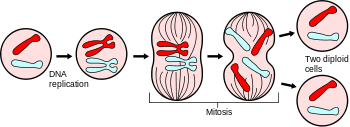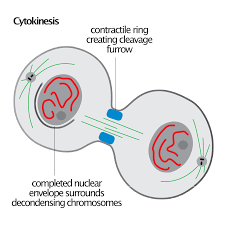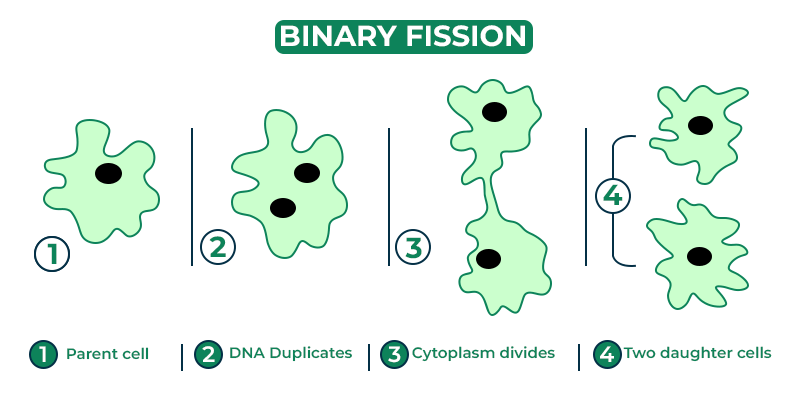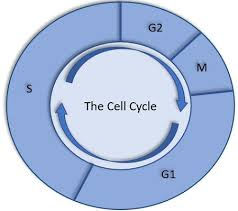organism regulation
why do cells divide?
growth:
we started as a sperm and egg to 37.3 trillion cells
repair: if you get a cut in your skin, overtime it heals.
Asexual reproduction: how simple organism give rise to their offspring
Bonary fiision:
is an asexual reproduction process in prokaryotes and single-celled eukaryotes, where bacterial cells replicate their DNA, form a wall, and divide into two cells.
mitosis:
The process by which a cell replicates its chromosomes and then segregates them, producing two identical nuclei in preparation for cell division.
phases: PMAT
prophase, metaphase, anaphase, telophase.
 Phases:
Phases:
interphase: refer to event between mitosis. the cell replicates the nuclear material ready
prophase is divided into two:
Early prophase: mitotic spindle starts to form, the chromosomes start to condense, and the nucleolus disappears.
late prophase: the mitotic spindle begins to capture and organize the chromosomes.
Metaphase:
some spindle fibers attach to and organize the chromosome on the equator of the cell (middle). some spindle fibers span the cell.
Anaphase: Spindle fiber attached to chromatids shorten, pulling the chromatids apart.
telophase: The new nuclei form. A furrow forms across the middle of the parent cell pinching it in two.
cytokinesis: physical process of cell division, which divides the cytoplasm of a parental cell into two daughter cells.



 .
.
Binary fission: mitosis for bacterial cells
a type of asexual reproduction typically observed in prokaryotes and a few single-celled eukaryotes. The division of the parent body into two, fairly equal, part to produce two identical cells
 CELL CYCLE:
CELL CYCLE:
interphase: is the time when the cell is not dividing.
G1: cell growth, protein production and some organelles
S-phase: growth and DNA replication in perpetration for nuclear division
G2: growth and preparation for mitosis. it stores energy and all of the other organelles have to be replicated.
G0: when a cell does not need to undergo mitosis it may go into G0 phase.
CELL REGULATION:
our cell have a control system to check whether all the important processes have been performed correctly before moving into the next phase.
there are 3 checkpoints:
checkpoints: is a critical regulatory point in the cell cycle.
G1 checkpoint
G2 checkpoint
M checkpoint
G1 checkpoint:
pass the checkpoint if:
cell size is large enough
sufficient nutrients are available
signals from other cells have been received.
G2 checkpoint:
pass the checkpoint if:
cell size i large enough
replication of chromosomes has been successfully completed
protein required for mitosis have been synthesized.
Metaphase checkpoint:
pass the checkpoint if:
all chromosomes are attacked to the mitotic spindle.
APOPTOSIS
also known as Programmed cell death, is a controlled process that eliminates faulty and infected cells from the body through a sequence of events.
Cell goes through a sequence of events:
1. Cell volume decreases and start shrinking.
2. Cell develops blebs (bubbles) at the membranes.
3. Nucleus gets fragmented.
4. Cell debris (or broken cell parts) removed by macrophages
 Disrupting the cell cycle:
Disrupting the cell cycle:
Cell cycle is strictly controlled, and failure of this control mechanism can disrupt the Cell Cycle.
The disruption of the cell cycle, caused by mutations in genes or chemical exposure, can lead to abnormal embryo development or tumor formation.
Mutagen:
is a substance or agent that courses DNA impairment that result in the alternation of DNA sequence.
e.g. bacteria, virous, and UV
carcinogens:
Carcinogens are mutations that cause cancer, as damaged cells fail to meet checkpoint requirements, causing rapid cell division and tumor formation.
Tumor:
are large masses of cancerous cell.
Cancerous cells evade the cell cycle checkpoint and divide rapidly coursing tumor.
Two types of genes control the cell cycle:
proto-oncogenes: which initiate cell division.
tumor-suppressor genes: which prevent division in response to DNA or cell damage.
oncogenes:
Mutations in genes regulating cell cycle can lead to negative consequences, such as oncogenes causing uncontrollable cell division and tumor-suppressor genes initiating most human cancers.
STEM CELLS:
are undifferentiated cells found in multicellular organisms. they are characterized by the properties of self-renewal and potency. they are unspecialized cells that can divide repeatedly while remaining unspecialized.
the two properties of stem cells are:
self-renewal: have the ability to divide many times while maintaining an unspecialized states.
potency: the ability to differentiate (transom) into specialized cells, there are different potency that depends on the type of stem cell.
types of stem cells:
EMBRYONIC STEM CELS:
are derived from the inner mass of blastocyst. cells derived from the inner cell mass are pluripotent meaning they can become any cell of the body with the exception of placental cells.
Totipotent stem cells, (high or most potency) found in zygotes, can differentiate into any cell in an organism.
Pluripotent stem cells: (high potency) can divide into most, or all, cell types in an organism, but cannot develop into an entire organism on their own.their ability to form all three of the basic body layers (ectoderm/endoderm/mesoderm) and even germ cells.
Adult stem cells: Multipotent least potency
Adult stem cells are undifferentiated cells found in several types of tissues like the brain and bones, that can differentiate into a small number of cell types usually related to the tissues or organs, as they are multipotent,
Adult stem cells, such as bone marrow and epithelial cells, differentiate into a limited number of tissue cell types, aiding in repair and replacement, but challenging to isolate and treat medical conditions.
Germ layers:
After the blastocyst implants, it forms a 'Gastrula', which undergoes changes to form germ layers, where stem cells differentiate into specific types.